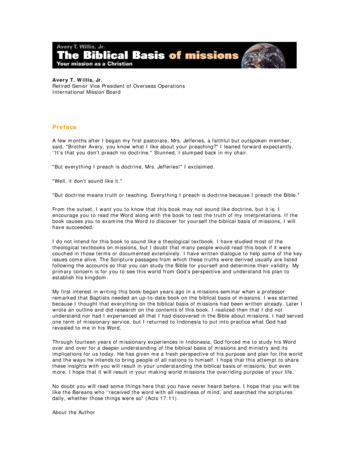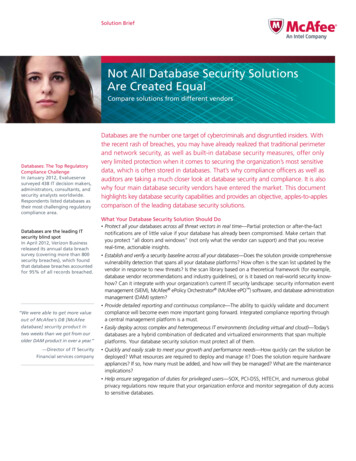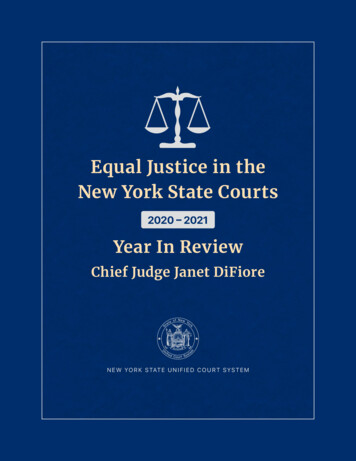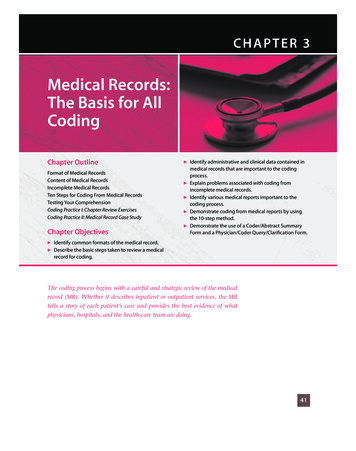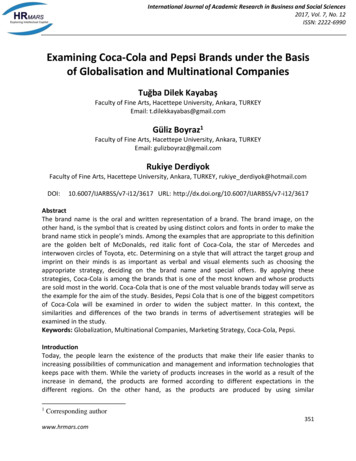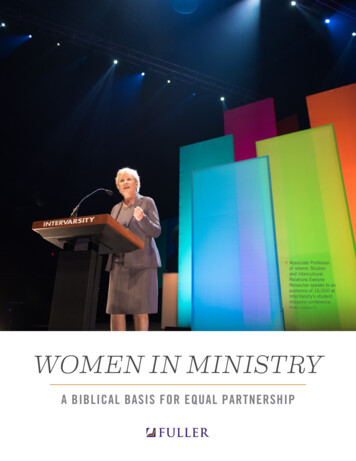
Transcription
Associate Professorof Islamic Studiesand InterculturalRelations EvelyneReisacher speaks to anaudience of 16,000 atInterVarsity’s studentmissions conference.Photo: Urbana 15WOMEN IN MINISTRYA BIBLICAL BASIS FOR EQUAL PARTNERSHIP
A FULLER COMMITMENTTO SUPPORTING WOMENWhen I was a new student at Fuller 40years ago, the seminary was in the midst ofan unexpected enrollment boom. Womenstudents were no longer present as a merehandful—their numbers were significant.Fuller had long had women students in class,but their presence in programs leading topastoral ministry was decidedly new.Forty years later, Fuller continues to addwomen to its students, staff, administration,and faculty. Our commitment to cultivatingleaders for an increasingly multicultural world,and for the mission of the church in thatworld, has entailed a like commitment to thefull and equal partnership of women in allour programs and in the work of the church.Simply put, as a seminary we have beensupporting women for rather a long time.The late David M. Scholer, beloved professorof New Testament at Fuller for many years,was an early and vocal advocate in thisarea. In the following article, he offers usan excellent review of the scriptural basisfor our convictions at Fuller about womenin ministry. Although written more thanthree decades ago, Dr. Scholer’s words arewell worth revisiting as he helps us, in hiswords, “reaffirm with clarity and convictionthe biblical basis for the full participation ofwomen in the ministries of the church.”MARIANNE MEYETHOMPSONGeorge Eldon LaddProfessor of NewTestament Fuller’s first female dean, MariClements, receives prayerfrom her School of Psychologycolleagues, trustees, and othersat her installation service
Kara Powell, Executive Director of theFuller Youth Institute and AssistantProfessor of Youth and Family MinistryA BIBLICAL BASIS FOR EQUAL PARTNERSHIP:WOMEN AND MEN IN THEMINISTRY OF THE CHURCHDavid M. ScholerWomen have contributed much to the ministry ofthe Church throughout its history. However, theirrole in this area has never been free from controversy.Today, most church bodies are discussing the placeof women in their ministries. Crucial to thesediscussions for many of us are the matters of faithfulbiblical interpretation.Perhaps a few words should be said about theconcept of ministry itself on the basis of the NewTestament. Today, we tend to confuse our specificchurch traditions about ordination with the biblicalconcept of ministry. The New Testament saysrelatively little about ordination. It clearly portrays,however, the fact that the early church had a variedand faithful ministry arising from the fact that all ofGod’s people were “gifted” by the Holy Spirit for thepurpose of building up one another (see, for example,1 Corinthians 12:4–31; 14:1–19; Romans 12:3–8;Ephesians 4:7–16; 1 Peter 4:8–11). Any person couldexercise ministry (which means, remember, service)who was called and gifted by God and affirmed by thebody of Christ, the Church. Some were set apart inleadership positions and some were assigned specifictasks to accomplish, but the differences amongministries were not distinctions of kind. Eventually,certain types of affirmation were combined withcertain functions of ministry to produce our currentunderstanding of ordination.Modern debates over the ordination of women oftenmiss the crucial and basic issues of the holistic conceptof the ministry of the Church reflected in the NewTestament. Of course, no person should be ordainedor given any responsibilities of ministry within theChurch because of gender or for the sake of a “point.”On the other hand, we have affirmed in the Churchthat no person, called and gifted by God, should bedenied any role of ministry or leadership in the Churchbecause of one’s gender.
THE BASIS IN CREATIONThe basic foundation of the partnership of womenand men in God’s creation and in the Church and itsministry is given in the opening chapter of Genesis.Here are found two fundamental perspectives,which should inform our thinking about personsand mutual relationships.First, man (‘adam), a generic term meaning the“human person,” is created in God’s very ownimage (Genesis 1:26–27; 5:1–2). This creation inGod’s image includes the identification of personsas male and female. This mutuality of women andmen carries no suggestion of male headship orfemale submission.Second, this mutuality is confirmed by the fact thatboth the man and the woman together, withoutdistinction, are charged with responsibility forall of God’s creation (Genesis 1:26, 28). This equalpartnership between man and woman is alsopresent in the retelling of the creation story inGenesis 2. Here the man is found in need of acompanion, but none of the creatures God hascreated qualify (Genesis 2:18–20). Thus, Goddifferentiates man (‘adam) into man (‘ish) andwoman (‘ishshah), persons of separate maleand female gender identity. The point of such aprovision of companionship is to relate the maleand female persons as equals, indicated by thecommon designations (‘ish/’ishshah; the sameword root) and the common identity of bone andflesh (Genesis 2:23). This is climaxed with theconcept of mutuality expressed in the “one flesh”language (Genesis 2:24).Some have interpreted Genesis 2:23, in which theman (‘ish) calls the “bones of my bones and fleshof my flesh” woman (‘ishshah), as an act of namingthat demonstrates the headship or authority of manover woman. However, that type of naming doesnot occur until after the Fall when “Adam namedhis wife Eve” (Genesis 3:20).Genesis 2 also indicates that the woman partnerwith the man will be an appropriate “helper”(Genesis 2:18). The word “helper” (‘ezer), when usedof a person in the Old Testament, always refers toGod (in 29 places) apart from one reference to David.The word “helper,” then, is not to be understood asan expression of submission and service to man;rather, the woman as helper serves God with man.The woman and man sin together (Genesis 3:1–7).Although it does not show in English translations,the serpent addresses the woman with the plural“you.” Genesis 3:6 states that the woman “gavesome [of the fruit] to her husband, who was withher, and he ate it.” The fact that the man was withher (a phrase sometimes omitted from Englishtranslations!) indicates that both partners aretogether involved in disobedience to God. This isalso seen by the fact that it is after both ate that it issaid: “Then the eyes of both of them were opened”(Genesis 3:7).The statements of judgment for disobedience(Genesis 3:14–19) are descriptive ones of futurerealities, which involved a supremacy/subjectionrelationship between man and woman. Thesestatements are not creation mandates; rather, therelationship of mutuality, partnership, and equalityportrayed in Genesis 1:1–3:7 is now sadly marred bysin.THE BASIS IN JESUS’ MINISTRYIn the time of Jesus’ ministry, women were usuallyregarded as subordinate and inferior in virtuallyevery area of life. They were to remain at home, tobe good wives and mothers, and to take no part inpublic discourse or education. Josephus, a Jewishhistorian, said: “The woman, says the Law, is inall things inferior to the man. Let her accordinglybe submissive.” It was also said: “Better is thewickedness of a man than a woman who does good”(Sirach).Jesus, however, by his teaching and actions,affirmed the worth and value of women as personsto be included along with men within God’s loveand service. Jesus challenged “sexual put-downs”of women. In Jesus’ setting, the prerogative ofdivorce belonged almost exclusively with men, andvirtually any reason could be used to justify divorce.
Jesus tolerated no such “male chauvinism.” Herecalled the “one flesh” concept (Genesis 2:24) of mutualpartnership and God’s intention for marriage (Matthew19:3–9). Although women were held responsible, in Jesus’time, for all sexual sin, Jesus rejected this “sexism” withhis dramatic indictment of men: “anyone who looks at awoman lustfully has already committed adultery withher in his heart” (Matthew 5:28). Jeanelle Austin, Director of Operations,Pannell Center for African AmericanChurch StudiesJesus reached out to women who were rejected. In spite ofthe laws regarding uncleanness, Jesus allowed a womanwith a twelve-year menstrual problem to touch him, andhe commended her faith (Mark 5:25–34). Jesus permitteda sinful woman to anoint and kiss his feet (Luke 7:36–50).Jesus challenged religious leaders by saying: “I tell youthe truth, the tax collectors and prostitutes are enteringthe kingdom of God ahead of you” (Matthew 21:31). He alsooffered salvation directly to women who were known asadulteresses (John 4:4–42 and John 8:1–11).In Jesus’ day responsible teachers were not to teachwomen. Nevertheless, Jesus taught women and includedthem in his group of committed disciples. He taught Maryof Bethany and commended her learning to her sisterwho was carrying out the traditional tasks (Luke 10:38–42). It was to the Samaritan woman that Jesus madehis most explicit affirmation that he was the Messiah,and he shared with her his basic mission (John 4:4–42).According to Luke 8:1–3, many women were in Jesus’band of traveling disciples. These same women werepresent at the crucifixion and burial and on resurrectionmorning (Luke 23:49, 55–56; 24:1).Jesus affirmed the value of committed discipleship andobedience to God, even over the natural and valued roleof mother: “My mother and brothers are those who hearGod’s word and put it into practice” (Luke 8:21), and“Blessed [rather than his own mother] are those who hearthe word of God and obey it” (Luke 11:28).The women Jesus included became the proclaimers ofJesus as Savior and risen Lord. The Samaritan womanwas responsible for evangelizing her town (John 4:39–42).All of the Gospels show that it was Jesus’ women discipleswho were the first persons to declare the message of Jesus’resurrection, central to the gospel in the early church. Cynthia Eriksson, Associate Professorof Psychology, Department of ClinicalPsychology
Among Jesus’ disciples we know of seventeen menby name: the Twelve, Joseph Justus, and Matthias(Acts 1:23), Lazarus, Nicodemus, and Joseph ofArimathea. What is not so often noted is thatwe also know women by name from among hiscircle of devoted disciples: Mary the mother, MaryMagdalene, the “other” Mary, Mary of Bethany,Joanna, Susanna, and Salome.Pentecost to mean that the “last days” of God’s timehad come and that God’s Spirit was poured out onboth women and men enabling them to prophesy.This foundational role was significant in theearly church (see Acts 21:8–9; 1 Corinthians 11:5).Throughout the history of the modern church,the events of Acts 2 have been one of the majorarguments in favor of women in ministry.Jesus’ inclusion of and ministry to and throughwomen within his own life and teaching werea powerful witness to the early church of thepartnership of women and men within itsmembership and ministry.Second, the involvement of women in theestablishment of the Philippian church isnoteworthy (Acts 16:11–40). Paul begins the churchin Philippi, the leading city of its district, with agroup of women gathered for prayer outside the citygate (Acts 16:13–15). The “place of prayer” here isprobably to be understood as a synagogue. Clearlyone of the leaders of this remarkable women’ssynagogue was Lydia. She and her home becamethe center of the new Philippian church (Acts 16:14–15, 40). This data is very significant background forthe two women of Philippi who worked with Paulin the gospel ministry (Philippians 4:2–3).THE BASIS IN THE EARLY CHURCHThe Book of Acts shows clearly that women werepart of the first church in Jerusalem and wereincluded as the church grew and spread. The groupof 120 disciples (Acts 1:15) who waited in Jerusalemfor the coming of the Holy Spirit included womensuch as those previously mentioned in Luke asdisciples who followed Jesus and Mary the motherof Jesus (Acts 1:14). That women continued as partof the growing church in Jerusalem is attested byLuke’s comments that “more and more men andwomen believed in the Lord and were added to thenumber” (Acts 5:14), and that Saul, in his persecutionof the Jerusalem church, “dragged off men andwomen and put them in prison” (Acts 8:3; see also22:4). Women are frequently mentioned in Acts asthe account of the spread of the church is given,including the widows in Joppa, Timothy’s motherin Lystra, the women in Philippi, the prominentwomen who joined the church in Thessalonica, theprominent women in Berea who believed, Damarisin Athens, Priscilla in Corinth, the wives in Tyre,and Philip the evangelist’s four daughters who hadthe gift of prophecy in Caesarea.Apart from documenting the widespread presenceof women in the early church, the account inActs presents us with three additional items ofimportance. First is the fact that when the HolySpirit came in power and in fulfillment of God’sWord (Joel 2:28–32) both men and women werepresent (Acts 1–2). Peter interpreted the events ofThird, Acts gives some indication of the importanceof Priscilla (Acts 18:2, 18, 26). She, along with herhusband, Aquila, instructed Apollos, who becamea noted teacher in the church (Acts 18:26). Therehas always been debate over the significance of thefact that Priscilla taught Apollos at home ratherthan in the church, but it must be recognized thatshe did teach Apollos (see 1 Timothy 2:12).THE BASIS IN PAULGalatians 3:28, like Acts 2, has been cited forhundreds of years as a basis for women in ministry.Detractors of women in ministry often argue thatGalatians 3:28 refers only to the spiritual realityof equal access to God through faith in ChristJesus. The text does refer to this, but it clearlyencompasses other realities as well. There arethree traditional pairings, and they reflect thethree basic social divides of hostility within thefirst century AD in the Roman Empire. Paul’sdeclaration would have had no less actual socialimpact than an American preacher’s statementin the 1950s that “in Christ Jesus there is neitherBlack nor White” would have had.
Further, the conflict of Paul and Peter recorded inGalatians 2:11–14 demonstrated that the declarationof “neither Jew nor Greek” had social implicationsin the life of the church. Paul’s letter to Philemonhas similar implications for “neither slave norfree” in asking Philemon to accept Onesimus as adear brother in the Lord just like Paul (Philemon15–17)! Paul’s declaration about male and femalehad implications, too, for the life of the church.The point is not the obliteration of God’s createddifferences between male and female, but thatsexual differentiation does not determine theparticipation in Christ’s Church for persons createdin the image of God.Paul also notes the mutuality of men and womenin Christ in two striking passages in 1 Corinthians.In 1 Corinthians 7:3–5 Paul makes it clear thatsexual relations between a husband and wife arematters of mutuality and equality in respect andin rights. Such a position grew out of the love andinclusiveness of Christ and was directly counterto the prevailing Jewish and pagan opinion in theRoman Empire that the husband had all the sexualrights over his wife. In 1 Corinthians 11:11–12 Paulincludes a strong and explicit assertion of themutuality of men and women lest his discussionabout head coverings be misunderstood as againstwomen’s participation.The discussion of head coverings for women in 1Corinthians 11:2–16 clearly implies and assumesthat women, as well as men, engage in prayer andprophecy (1 Corinthians 11:5). The participation inprophecy is the “highest” gift in the Church becauseit is the means of edification, encouragement, andcomfort in the Church (1 Corinthians 14:3). Suchedification is the purpose of the Church’s lifetogether and constitutes, under the Holy Spirit, theexercise of authority and teaching in the Church.Thus, Paul concludes the first part of his discussionon head coverings (1 Corinthians 11:2–10) by statingthat women ought to have authority on theirheads. First Corinthians 11:10 is rarely translatedaccurately in English (most often one finds “a signof authority” or “veil”), but Paul asserts that womenhave authority, using his normal word, whichalways means the active exercise of authority (andnever the passive reception of it).Paul’s letters also mention twelve women byname who were coworkers with him in thegospel ministry. This is the most often neglectedevidence from the New Testament relevant to theparticipation of women in ministry. Pamela Ebstyne King, Peter L.Benson Associate Professor ofApplied Developmental Science
Three women are known as leaders of housechurches (the only type of church there was in thefirst century!): Chloe (1 Corinthians 1:11), Nympha(Colossians 4:15) and Apphia (Philemon 2). To thisgroup we can add Lydia, a Pauline house churchleader known from Acts 16.Paul stated that four women—Mary, Tryphena,Tryphosa, and Persis (Romans 16:6, 12)—hadworked very hard in the Lord. The Greek wordtranslated “work very hard” was used veryregularly by Paul to refer to the special work ofthe gospel ministry, including his own apostolicministry (1 Corinthians 4:12; 15:10; Galatians 4:11;Philippians 2:16; Colossians 1:29; 1 Timothy 4:10;see also Acts 20:35) as well as the work of othersin the ministry, leaders and persons of authority ineach case (1 Corinthians 16:15–16; 1 Thessalonians5:12; 1 Timothy 5:17). Thus, for Paul, the term “workvery hard” was not a casual term referring tomenial tasks.In Romans 16:3–4 Paul greeted Priscilla andAquila. This husband and wife team is mentionedsix times elsewhere in the New Testament. It issignificant that Priscilla is usually mentionedfirst, since the cultural pattern would be to namethe husband first. This may indicate that Priscillawas the more important or visible leader and maysuggest that she had a higher social status and/or more wealth than Aquila. Paul indicated thathe and all the Gentile churches were indebted toboth of them. Paul designated Priscilla and herhusband, Aquila, “fellow workers in Christ Jesus,”a term used regularly for other leaders in the gospelministry: Urbanus (Romans 16:9), Timothy (Romans16:21), Titus (2 Corinthians 8:23), Epaphroditus(Philippians 2:25), Clement (Philippians 4:3),Philemon (Philemon 1), Demas and Luke (Philemon24), Apollos and himself (1 Corinthians 3:9), andseveral others (Colossians 4:11).In Philippians 4:2–3 Paul mentioned two women,Euodia and Syntyche, whom he also classed “alongwith Clement and the rest of my fellow workers,”and noted that these two women fellow workers“contended at my side in the cause of the gospel,”an expression similar to the “worked very hard inthe Lord” phrase applied to the four women notedin Romans 16. In view of Acts 16:11–40 it is notsurprising that two such women leaders emergedin the Philippian church.Phoebe, usually assumed to have been the one todeliver Paul’s letter to Rome, is warmly commendedby Paul to the Roman church (Romans 16:1–2).Phoebe is designated as “a servant of the church inCenchrea.” Although some have thought the word“servant” here means “deacon” (or “deaconess”),that is most unlikely since the other New Testamenttexts that refer to the office of deacon mention theoffice of bishop in immediate conjunction with it(Philippians 1:1; 1 Timothy 3:8, 12). Paul regularlyused this term “servant” to refer to personsclearly understood to be ministers of the gospel:Christ (Romans 15:8), Apollos (1 Corinthians 3:5),Epaphras (Colossians 1:7), Timothy (1 Timothy 4:6),Tychicus (Ephesians 6:21; Colossians 4:7), himself(1 Corinthians 3:5; Ephesians 3:7; Colossians 1:23,25), and generally (2 Corinthians 3:6; 6:4; 11:15, 23).Thus, Phoebe should be understood as well as theminister (leader/preacher/teacher) of the churchin Cenchrea.Paul identified Andronicus and Junias as“outstanding among the apostles” (Romans 16:7),an expression that includes them within theapostolic circle. Junias is a male name in Englishtranslations, but there is no evidence that such amale name existed in the first century AD. Junia,a female name, was common, however. The Greekgrammar of the sentence in Romans 16:7 meansthat the male and female forms of this name wouldbe spelled identically. Thus, one has to decide—onthe basis of other evidence—whether this personis a woman (Junia) or a man (Junias). Since Juniais the name attested in the first century and sincethe great church father and commentator on Paul inthe fourth century, John Chrysostom (no friend ofwomen in ministry), understood the reference to bea woman Junia, we ought to read it that way as well.In fact, it was not until the thirteenth century thatshe was changed to Junias!
These thirteen women surveyed here (Lydia, Chloe,Nympha, Apphia, Mary, Persis, Tryphena, Tryphosa,Priscilla, Euodia, Syntyche, Phoebe, and Junia)provide clear evidence from Paul that women didparticipate in the gospel ministry, as did men. Paul’scommon terminology made no distinctions in rolesor functions between men and women in ministry.1 CORINTHIANS 14:34–35First Corinthians 14:34–35 is one of the two texts fromthe New Testament often used as a major argumentagainst preaching, teaching, and leadershipministries for women in the church. If one believesthat the Bible supports women in ministry, then anadequate, biblical explanation must be offered forthis apparent prohibition.It should be recalled that Paul has already indicatedin this letter—1 Corinthians—that women didparticipate in prayer and prophecy with authority inthe church (1 Corinthians 11:5, 10; 14:3–5). This factalone shows that 1 Corinthians 14:34–35 cannot be ageneral, absolute, and timeless prohibition on womenspeaking in church.It was common at one time to “dismiss” the evidenceof 1 Corinthians 11:5, 10 (and a few would still arguethis position). It was suggested that 1 Corinthians11:2–16 did not refer to a meeting of the church butonly to a private non-church gathering. The wholecontext of 1 Corinthians 11:2–14:40, the argumentof 1 Corinthians 11:16, and the parallel between1 Corinthians 11:2 and 11:17 make such an ideamost untenable. Some have even suggested that 1Corinthians 11:5 was only hypothetical, but such anapproach is clearly an argument of desperation. Alexis Abernethy, Professorof Psychology, Department ofClinical PsychologyThe silence enjoined in 1 Corinthians 14:34–35 mustbe a specific, limited silence. Numerous suggestionshave been offered, but only the major alternatives canbe reviewed here (some scholars, with slight evidence,have also suggested either that 1 Corinthians 14:34–35 was not written by Paul but was inserted by acopyist or that it is a question from Paul’s opponentsin Corinth which Paul denounces in 1 Corinthians14:36). One view is that the speaking prohibitedhere is mere babbling. There is, however, nothing
specific in the context to support this meaning of“speak,” and such nonsense would certainly havebeen prohibited to all persons in the worship Pauldescribed. Another view suggests that the speakingprohibited is speaking in tongues (glossolalia)since that is frequently mentioned in the precedingcontext (1 Corinthians 14). However, glossolaliais always referred to as “tongues” or “speaking intongues” and never simply as speaking.questioning also fits well the specific context (1Corinthians 14:26–40) in which Paul is concernedabout appropriateness and order, which permitgenuine edification (note that 1 Corinthians 14:26expects everyone to participate). Thus, there areactually three injunctions to silence (1 Corinthians14:2, 30, 34), although many Bible translations use“silent” only in 1 Corinthians 14:34.Probably the most popular view today among thosewho oppose women speaking with authority inthe church is to identify the speaking prohibitedwith the judgment of the prophets mentioned in 1Corinthians 14:29. Thus, it is argued that womenmay prophesy (1 Corinthians 11:5) but may not judgeor evaluate prophecy. The evaluation of prophecy isseen as the truly authoritative level of speech in thechurch from which women are to be excluded.First Timothy 2:8 –15 is the paragraph in the NewTestament that provides the injunctions (2:11–12)most often cited as conclusive by those who opposepreaching, teaching, and leadership ministries forwomen in the church. It is inappropriate, however, toisolate verses 11–12 from the immediate context of 1Timothy 2:8–15. If any of the paragraph is perceivedas culturally bound (as 2:8–10 often is) or as especiallydifficult in terms of Pauline theology (as 2:15 oftenis), it must be realized that these same issues must beconfronted in understanding 2:11–14.This view has two major difficulties. First, the word“speak” in 1 Corinthians 14:34 has no implicationwithin the word itself or in its immediate context(14:34–35) to support identifying it with the conceptof prophetic evaluation. Second, the idea of twolevels of speech in the church—prophecy and thejudgment of prophecy—with the understandingthat one is higher than the other and is for menonly has no clear or implied support elsewhere inPaul. In fact, Paul’s own definition and defense ofprophecy (1 Corinthians 14:1–25) implies directlythat prophecy itself is authoritative speech of thehighest level in the church.The view that seems best to me is to understand thespeaking prohibited here to women to refer only todisruptive questions that wives (usually uneducatedin the culture of Paul’s time) were asking theirhusbands. This corresponds precisely with theresolution Paul offers (1 Corinthians 14:35): “if theywant to inquire about something, they should asktheir own husbands at home. . . .” Such disruptivequestioning was also considered a disgrace inPaul’s day in which it was widely believed that itwas morally indiscreet for any wife to say anythingon any subject in public. This view of disruptive1 TIMOTHY 2:8–15It should also be observed that 1 Timothy 2:11–12is a general prohibition on teaching and authorityexercised by women. It is not directed to only a certainlevel of persons (such as “ordained” in distinctionfrom “non-ordained” or “pastors” as distinct from“missionaries”). Further, it is not limited to onlycertain styles of teaching (“preaching” as distinctfrom “sharing,” seminary teaching, or writingtheological books). In other words, if 1 Timothy2:11–12 were a transcultural, absolute prohibitionon women teaching and exercising authority in thechurch, then it prohibits all such activity.The word in verses 11 and 12 often translated as “inquietness” (11) and “silent” (12) is identical in Greek.The same term is used by Paul in 2 Thessalonians3:12, which the NIV translates as “settle down.” Thepoint is that this term, which is often assumed tomean only “verbal silence,” is better understood asan indication of proper order or acceptance of normalpractice. The term translated “to have authority”(authentein) occurs only here in the New Testamentand was rarely used in the Greek language. It is notthe usual word for positive, active authority. Rather,
it is a negative term, which refers to the usurpationand abuse of authority. Thus, the prohibition (2:11–12)is against some abusive activity, but not against theappropriate exercise of teaching and authority inthe church. The clue to the abuse implied is foundwithin the heretical activity outlined in 1–2 Timothy.The heretics evidently had a deviant approach tosexuality (1 Timothy 4:3; 5:11–15) and a particularfocus on deluding women, who were generallyuneducated (2 Timothy 3:6–7).The injunctions are supported with selective Genesisarguments (1 Timothy 2:13–14), using Genesis 2rather than Genesis 1 (2:13) and the fact of Eve’sdeception (2:14, see the use of this in 2 Corinthians11:3 for male heretics). The function of the Genesisargument is parallel to its use in 1 Corinthians 11:7–9where it is employed to argue that women must havetheir heads covered in prayer and prophecy. In bothcases scriptural argument is employed to buttress alocalized, limited instruction. The concluding wordof hope for women (1 Timothy 2:15) is an affirmationof the role of bearing and nurturing children, a roleconsidered as the only appropriate one by many in theculture who believed women incapable of other rolesas well. This conclusion (2:15) is parallel in thrust to1 Timothy 5:3–16 and Titus 2:3–5, both of which areconcerned with specific cultural expectations.CONSISTENCY AND BALANCETwo broad and basic issues of responsible biblicalinterpretation should concern us in this, indeed,in any issue—balance and consistency. In termsof balance, it is the total witness of Scripturethat must inform our thought and action. Interms of consistency, it is crucial to approach ourunderstanding of all biblical texts in the same wayin order to offset as much as possible our blind spotsand biases.Opposition to women in ministry has often beenmounted virtually on the basis of one Paulinetext—1 Timothy 2:11–12. Whatever that difficult textand context means, it must be put in balance with allother biblical texts that bear on the same issue. Thisshows, in my judgment, that the 1 Timothy text does,in fact, speak to a limited situation. Jude Tiersma Watson, AssociateProfessor of Urban Mission Miyoung Yoon Hammer, AssociateProfessor of Marital and FamilyTherapy and Chair, Department ofMarriage and Family
Lisseth Rojas-Flores,Associate Professor ofMarital and Family TherapyFurther, in regard to balance, one must struggle withstarting points. For example, on the matter of “eternalsecurity” of believers, does one read Hebrews 6:4–6“through” Romans 8:28–39, or should the Romanstext be read “through” the one from Hebrews? It hasoften been assumed without question that 1 Timothy2:11–12 is the “control” (i.e., authoritative) text throughwhich all other New Testament data on women inministry must be challenged. It is more plausible, inmy judgment, to approach 1 Timothy 2:8–15 throughthe accumulated wit
all of God’s creation (Genesis 1:26, 28). This equal partnership between man and woman is also present in the retelling of the creation story in Genesis 2. Here the man is found in need of a companion, but none of the creatures God has created qualify (Genesis 2:18–20). Thus, Go

